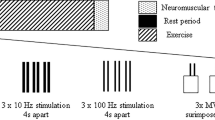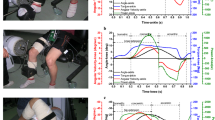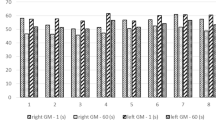Abstract
Desmedt and Hainaut1 have interpreted their findings on the staircase phenomenon of normal human muscle in situ in terms of the “kinetics of myofilament activation”, and find themselves at variance with the current explanation of the phenomenon according to which the potentiation of the twitch force is due to a prolongation of the “active state”2 as defined by Hill3. The disagreement is based on the finding of a shortening of the contraction time of the isometric twitch in staircase potentiation4–6. Desmedt and Hainaut1 argue that this finding rules out (a) that the potentiation is caused by a prolongation of the decay of the “active state”, and (b) that the “active state” reaches maximum in a single twitch. Instead, they suggest that the staircase phenomenon is a result of an intensification of the “active state”7, early in the contraction cycle of the twitch.
This is a preview of subscription content, access via your institution
Access options
Subscribe to this journal
Receive 51 print issues and online access
$199.00 per year
only $3.90 per issue
Buy this article
- Purchase on Springer Link
- Instant access to full article PDF
Prices may be subject to local taxes which are calculated during checkout
Similar content being viewed by others
References
Desmedt, J. E., and Hainaut, K., Nature, 217, 529 (1968).
Ritchie, J. M., and Wilkie, D. R., J. Physiol., 130, 488 (1955).
Hill, A. V., Proc. Roy. Soc., B, 136, 399 (1949).
Desmedt, J. E., and Hainaut, K., CR Acad. Sci., 264, 363 (1967).
Slomic, A., Rosenfalck, A., and Buchthal, F., Brain Res. (in the press).
Brust, M., and Cosla, H. W., Arch. Phys. Med. Rehab., 48, 543 (1967).
Abbott, B. C., and Mommaerts, W. F. H. M., J. Gen. Physiol., 42, 533 (1959).
Jewell, B. R., and Wilkie, D. R., J. Physiol., 152, 30 (1960).
Aubert, X., Le Couplage Energétique de la Contraction Musculaire, 233 (Arscia, Bruxelles, 1956).
Wilkie, D. R., J. Physiol., 110, 249 (1950).
Jewell, B. R., and Wilkie, D. R., J. Physiol., 143, 515 (1958).
Ritchie, J. M., and Wilkie, D. R., J. Physiol., 143, 104 (1958).
Pringle, J. W. S., Symp. Soc. Exp. Biol., 14, 41 (1960).
Buchthal, F., and Rosenfalck, P., Acta. Physiol. Scand., 49, 198 (1960).
Author information
Authors and Affiliations
Rights and permissions
About this article
Cite this article
ROSENFALCK, P. Staircase Phenomenon of Human Muscle : Relation to the Active State. Nature 218, 958–959 (1968). https://doi.org/10.1038/218958a0
Received:
Issue Date:
DOI: https://doi.org/10.1038/218958a0
This article is cited by
Comments
By submitting a comment you agree to abide by our Terms and Community Guidelines. If you find something abusive or that does not comply with our terms or guidelines please flag it as inappropriate.



